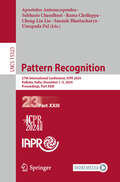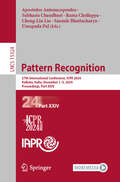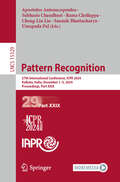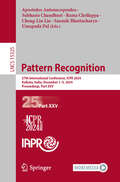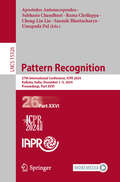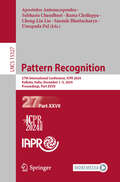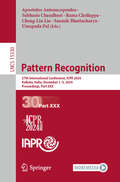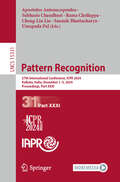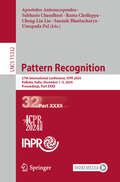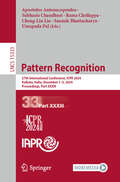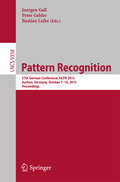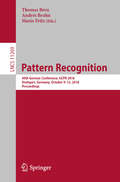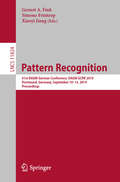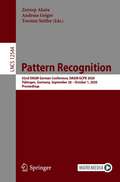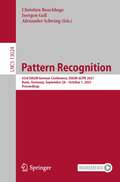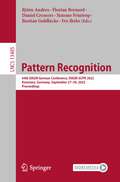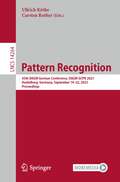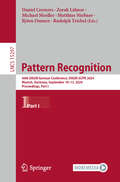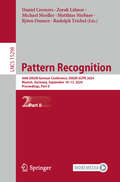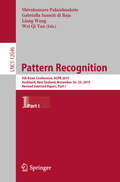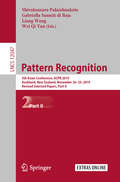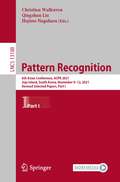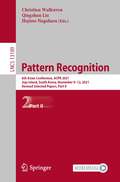- Table View
- List View
Pattern Recognition: 27th International Conference, ICPR 2024, Kolkata, India, December 1–5, 2024, Proceedings, Part XXIII (Lecture Notes in Computer Science #15323)
by Rama Chellappa Subhasis Chaudhuri Cheng-Lin Liu Umapada Pal Apostolos Antonacopoulos Saumik BhattacharyaThe multi-volume set of LNCS books with volume numbers 15301-15333 constitutes the refereed proceedings of the 27th International Conference on Pattern Recognition, ICPR 2024, held in Kolkata, India, during December 1–5, 2024. The 963 papers presented in these proceedings were carefully reviewed and selected from a total of 2106 submissions. They deal with topics such as Pattern Recognition; Artificial Intelligence; Machine Learning; Computer Vision; Robot Vision; Machine Vision; Image Processing; Speech Processing; Signal Processing; Video Processing; Biometrics; Human-Computer Interaction (HCI); Document Analysis; Document Recognition; Biomedical Imaging; Bioinformatics.
Pattern Recognition: 27th International Conference, ICPR 2024, Kolkata, India, December 1–5, 2024, Proceedings, Part XXIV (Lecture Notes in Computer Science #15324)
by Rama Chellappa Subhasis Chaudhuri Cheng-Lin Liu Umapada Pal Apostolos Antonacopoulos Saumik BhattacharyaThe multi-volume set of LNCS books with volume numbers 15301-15333 constitutes the refereed proceedings of the 27th International Conference on Pattern Recognition, ICPR 2024, held in Kolkata, India, during December 1–5, 2024. The 963 papers presented in these proceedings were carefully reviewed and selected from a total of 2106 submissions. They deal with topics such as Pattern Recognition; Artificial Intelligence; Machine Learning; Computer Vision; Robot Vision; Machine Vision; Image Processing; Speech Processing; Signal Processing; Video Processing; Biometrics; Human-Computer Interaction (HCI); Document Analysis; Document Recognition; Biomedical Imaging; Bioinformatics.
Pattern Recognition: 27th International Conference, ICPR 2024, Kolkata, India, December 1–5, 2024, Proceedings, Part XXIX (Lecture Notes in Computer Science #15329)
by Rama Chellappa Subhasis Chaudhuri Cheng-Lin Liu Umapada Pal Apostolos Antonacopoulos Saumik BhattacharyaThe multi-volume set of LNCS books with volume numbers 15301-15333 constitutes the refereed proceedings of the 27th International Conference on Pattern Recognition, ICPR 2024, held in Kolkata, India, during December 1–5, 2024. The 963 papers presented in these proceedings were carefully reviewed and selected from a total of 2106 submissions. They deal with topics such as Pattern Recognition; Artificial Intelligence; Machine Learning; Computer Vision; Robot Vision; Machine Vision; Image Processing; Speech Processing; Signal Processing; Video Processing; Biometrics; Human-Computer Interaction (HCI); Document Analysis; Document Recognition; Biomedical Imaging; Bioinformatics.
Pattern Recognition: 27th International Conference, ICPR 2024, Kolkata, India, December 1–5, 2024, Proceedings, Part XXV (Lecture Notes in Computer Science #15325)
by Rama Chellappa Subhasis Chaudhuri Cheng-Lin Liu Umapada Pal Apostolos Antonacopoulos Saumik BhattacharyaThe multi-volume set of LNCS books with volume numbers 15301-15333 constitutes the refereed proceedings of the 27th International Conference on Pattern Recognition, ICPR 2024, held in Kolkata, India, during December 1–5, 2024. The 963 papers presented in these proceedings were carefully reviewed and selected from a total of 2106 submissions. They deal with topics such as Pattern Recognition; Artificial Intelligence; Machine Learning; Computer Vision; Robot Vision; Machine Vision; Image Processing; Speech Processing; Signal Processing; Video Processing; Biometrics; Human-Computer Interaction (HCI); Document Analysis; Document Recognition; Biomedical Imaging; Bioinformatics.
Pattern Recognition: 27th International Conference, ICPR 2024, Kolkata, India, December 1–5, 2024, Proceedings, Part XXVI (Lecture Notes in Computer Science #15326)
by Rama Chellappa Subhasis Chaudhuri Cheng-Lin Liu Umapada Pal Apostolos Antonacopoulos Saumik BhattacharyaThe multi-volume set of LNCS books with volume numbers 15301-15333 constitutes the refereed proceedings of the 27th International Conference on Pattern Recognition, ICPR 2024, held in Kolkata, India, during December 1–5, 2024. The 963 papers presented in these proceedings were carefully reviewed and selected from a total of 2106 submissions. They deal with topics such as Pattern Recognition; Artificial Intelligence; Machine Learning; Computer Vision; Robot Vision; Machine Vision; Image Processing; Speech Processing; Signal Processing; Video Processing; Biometrics; Human-Computer Interaction (HCI); Document Analysis; Document Recognition; Biomedical Imaging; Bioinformatics.
Pattern Recognition: 27th International Conference, ICPR 2024, Kolkata, India, December 1–5, 2024, Proceedings, Part XXVII (Lecture Notes in Computer Science #15327)
by Rama Chellappa Subhasis Chaudhuri Cheng-Lin Liu Umapada Pal Apostolos Antonacopoulos Saumik BhattacharyaThe multi-volume set of LNCS books with volume numbers 15301-15333 constitutes the refereed proceedings of the 27th International Conference on Pattern Recognition, ICPR 2024, held in Kolkata, India, during December 1–5, 2024. The 963 papers presented in these proceedings were carefully reviewed and selected from a total of 2106 submissions. They deal with topics such as Pattern Recognition; Artificial Intelligence; Machine Learning; Computer Vision; Robot Vision; Machine Vision; Image Processing; Speech Processing; Signal Processing; Video Processing; Biometrics; Human-Computer Interaction (HCI); Document Analysis; Document Recognition; Biomedical Imaging; Bioinformatics.
Pattern Recognition: 27th International Conference, ICPR 2024, Kolkata, India, December 1–5, 2024, Proceedings, Part XXVIII (Lecture Notes in Computer Science #15328)
by Rama Chellappa Subhasis Chaudhuri Cheng-Lin Liu Umapada Pal Apostolos Antonacopoulos Saumik BhattacharyaThe multi-volume set of LNCS books with volume numbers 15301-15333 constitutes the refereed proceedings of the 27th International Conference on Pattern Recognition, ICPR 2024, held in Kolkata, India, during December 1–5, 2024. The 963 papers presented in these proceedings were carefully reviewed and selected from a total of 2106 submissions. They deal with topics such as Pattern Recognition; Artificial Intelligence; Machine Learning; Computer Vision; Robot Vision; Machine Vision; Image Processing; Speech Processing; Signal Processing; Video Processing; Biometrics; Human-Computer Interaction (HCI); Document Analysis; Document Recognition; Biomedical Imaging; Bioinformatics
Pattern Recognition: 27th International Conference, ICPR 2024, Kolkata, India, December 1–5, 2024, Proceedings, Part XXX (Lecture Notes in Computer Science #15330)
by Rama Chellappa Subhasis Chaudhuri Cheng-Lin Liu Umapada Pal Apostolos Antonacopoulos Saumik BhattacharyaThe multi-volume set of LNCS books with volume numbers 15301-15333 constitutes the refereed proceedings of the 27th International Conference on Pattern Recognition, ICPR 2024, held in Kolkata, India, during December 1–5, 2024. The 963 papers presented in these proceedings were carefully reviewed and selected from a total of 2106 submissions. They deal with topics such as Pattern Recognition; Artificial Intelligence; Machine Learning; Computer Vision; Robot Vision; Machine Vision; Image Processing; Speech Processing; Signal Processing; Video Processing; Biometrics; Human-Computer Interaction (HCI); Document Analysis; Document Recognition; Biomedical Imaging; Bioinformatics.
Pattern Recognition: 27th International Conference, ICPR 2024, Kolkata, India, December 1–5, 2024, Proceedings, Part XXXI (Lecture Notes in Computer Science #15331)
by Rama Chellappa Subhasis Chaudhuri Cheng-Lin Liu Umapada Pal Apostolos Antonacopoulos Saumik BhattacharyaThe multi-volume set of LNCS books with volume numbers 15301-15333 constitutes the refereed proceedings of the 27th International Conference on Pattern Recognition, ICPR 2024, held in Kolkata, India, during December 1–5, 2024. The 963 papers presented in these proceedings were carefully reviewed and selected from a total of 2106 submissions. They deal with topics such as Pattern Recognition; Artificial Intelligence; Machine Learning; Computer Vision; Robot Vision; Machine Vision; Image Processing; Speech Processing; Signal Processing; Video Processing; Biometrics; Human-Computer Interaction (HCI); Document Analysis; Document Recognition; Biomedical Imaging; Bioinformatics.
Pattern Recognition: 27th International Conference, ICPR 2024, Kolkata, India, December 1–5, 2024, Proceedings, Part XXXII (Lecture Notes in Computer Science #15332)
by Rama Chellappa Subhasis Chaudhuri Cheng-Lin Liu Umapada Pal Apostolos Antonacopoulos Saumik BhattacharyaThe multi-volume set of LNCS books with volume numbers 15301-15333 constitutes the refereed proceedings of the 27th International Conference on Pattern Recognition, ICPR 2024, held in Kolkata, India, during December 1–5, 2024. The 963 papers presented in these proceedings were carefully reviewed and selected from a total of 2106 submissions. They deal with topics such as Pattern Recognition; Artificial Intelligence; Machine Learning; Computer Vision; Robot Vision; Machine Vision; Image Processing; Speech Processing; Signal Processing; Video Processing; Biometrics; Human-Computer Interaction (HCI); Document Analysis; Document Recognition; Biomedical Imaging; Bioinformatics.
Pattern Recognition: 27th International Conference, ICPR 2024, Kolkata, India, December 1–5, 2024, Proceedings, Part XXXIII (Lecture Notes in Computer Science #15333)
by Rama Chellappa Subhasis Chaudhuri Cheng-Lin Liu Umapada Pal Apostolos Antonacopoulos Saumik BhattacharyaThe multi-volume set of LNCS books with volume numbers 15301-15334 constitutes the refereed proceedings of the 27th International Conference on Pattern Recognition, ICPR 2024, held in Kolkata, India, during December 1–5, 2024. The 963 papers presented in these proceedings were carefully reviewed and selected from a total of 2106 submissions. They deal with topics such as Pattern Recognition; Artificial Intelligence; Machine Learning; Computer Vision; Robot Vision; Machine Vision; Image Processing; Speech Processing; Signal Processing; Video Processing; Biometrics; Human-Computer Interaction (HCI); Document Analysis; Document Recognition; Biomedical Imaging; Bioinformatics.
Pattern Recognition: 37th German Conference, GCPR 2015, Aachen, Germany, October 7-10, 2015, Proceedings (Lecture Notes in Computer Science #9358)
by Juergen Gall Peter Gehler Bastian LeibeThis book constitutes the refereed proceedings of the 37th German Conference on Pattern Recognition, GCPR 2015, held in Aachen, Germany, in October 2015. The 45 revised full papers and one Young Researchers Forum presented were carefully reviewed and selected from 108 submissions. The papers are organized in topical sections on motion and reconstruction; mathematical foundations and image processing; biomedical image analysis and applications; human pose analysis; recognition and scene understanding.
Pattern Recognition: 40th German Conference, GCPR 2018, Stuttgart, Germany, October 9-12, 2018, Proceedings (Lecture Notes in Computer Science #11269)
by Andrés Bruhn Thomas Brox Mario FritzThis book constitutes the refereed proceedings of the 40th German Conference on Pattern Recognition, GCPR 2018, held in Stuttgart, Germany, in October 2018. The 48 revised full papers presented were carefully reviewed and selected from 118 submissions. The German Conference on Pattern Recognition is the annual symposium of the German Association for Pattern Recognition (DAGM). It is the national venue for recent advances in image processing, pattern recognition, and computer vision and it follows the long tradition of the DAGM conference series, which has been renamed to GCPR in 2013 to reflect its increasing internationalization. In 2018 in Stuttgart, the conference series celebrated its 40th anniversary.
Pattern Recognition: 41st DAGM German Conference, DAGM GCPR 2019, Dortmund, Germany, September 10–13, 2019, Proceedings (Lecture Notes in Computer Science #11824)
by Gernot A. Fink Xiaoyi Jiang Simone FrintropThis book constitutes the proceedings of the 41st DAGM German Conference on Pattern Recognition, DAGM GCPR 2019, held in Dortmund, Germany, in September 2019. The 43 revised full papers presented were carefully reviewed and selected from 91 submissions. The German Conference on Pattern Recognition is the annual symposium of the German Association for Pattern Recognition (DAGM). It is the national venue for recent advances in image processing, pattern recognition, and computer vision and it follows the long tradition of the DAGM conference series.
Pattern Recognition: 42nd DAGM German Conference, DAGM GCPR 2020, Tübingen, Germany, September 28 – October 1, 2020, Proceedings (Lecture Notes in Computer Science #12544)
by Zeynep Akata Andreas Geiger Torsten SattlerThis book constitutes the refereed proceedings of the 42nd German Conference on Pattern Recognition, DAGM GCPR 2020, which took place during September 28 until October 1, 2020. The conference was planned to take place in Tübingen, Germany, but had to change to an online format due to the COVID-19 pandemic.The 34 papers presented in this volume were carefully reviewed and selected from a total of 89 submissions. They were organized in topical sections named: Normalizing Flow, Semantics, Physics, Camera Calibration and Computer Vision, Pattern Recognition, Machine Learning.
Pattern Recognition: 43rd DAGM German Conference, DAGM GCPR 2021, Bonn, Germany, September 28 – October 1, 2021, Proceedings (Lecture Notes in Computer Science #13024)
by Juergen Gall Christian Bauckhage Alexander SchwingThis book constitutes the refereed proceedings of the 43rd DAGM German Conference on Pattern Recognition, DAGM GCPR 2021, which was held during September 28 – October 1, 2021. The conference was planned to take place in Bonn, Germany, but changed to a virtual event due to the COVID-19 pandemic.The 46 papers presented in this volume were carefully reviewed and selected from 116 submissions. They were organized in topical sections as follows: machine learning and optimization; actions, events, and segmentation; generative models and multimodal data; labeling and self-supervised learning; applications; and 3D modelling and reconstruction.
Pattern Recognition: 44th DAGM German Conference, DAGM GCPR 2022, Konstanz, Germany, September 27–30, 2022, Proceedings (Lecture Notes in Computer Science #13485)
by Daniel Cremers Simone Frintrop Björn Andres Florian Bernard Bastian Goldlücke Ivo IhrkeThis book constitutes the refereed proceedings of the 44th DAGM German Conference on Pattern Recognition, DAGM GCPR 2022, which was held during September 27 – 30, 2022.The 37 papers presented in this volume were carefully reviewed and selected from 78 submissions. They were organized in topical sections as follows: machine learning methods; unsupervised, semi-supervised and transfer learning; interpretable machine learning; low-level vision and computational photography; motion, pose estimation and tracking; 3D vision and stereo; detection and recognition; language and vision; scene understanding; photogrammetry and remote sensing; pattern recognition in the life and natural sciences; systems and applications.
Pattern Recognition: 45th DAGM German Conference, DAGM GCPR 2023, Heidelberg, Germany, September 19–22, 2023, Proceedings (Lecture Notes in Computer Science #14264)
by Carsten Rother Ullrich KötheThis book constitutes the proceedings of the 45th Annual Conference of the German Association for Pattern Recognition, DAGM-GCPR 2023, which took place in Heidelberg, Germany, during September 19-22, 2023. The 40 full papers included in these proceedings were carefully reviewed and selected from 76 submissions. They were organized in topical sections as follows: Segmentation and action recognition; 3D reconstruction and neural rendering; Photogrammetry and remote sensing; Pattern recognition in the life sciences; Interpretable machine learning; Weak supervision and online learning; Robust models.
Pattern Recognition: 46th DAGM German Conference, DAGM GCPR 2024, Munich, Germany, September 10–13, 2024, Proceedings, Part I (Lecture Notes in Computer Science #15297)
by Daniel Cremers Zorah Lähner Michael Moeller Matthias Nießner Björn Ommer Rudolph TriebelThis 2-volume set LNCS 15297-15298 constitutes the refereed proceedings of the 46th Annual Conference of the German Association for Pattern Recognition, DAGM-GCPR 2024, held in Munich, Germany, during September 10-13, 2024.The 44 full papers included in these proceedings were carefully reviewed and selected from 81 submissions. They are organized in these topical sections:Part I: Clustering and Segmentation; Learning Techniques; Medical and Biological Applications; Uncertainty and Explainability.Part II: Modelling of Faces and Shapes; Image Generation and Reconstruction; 3D Analysis and Sythesis; Video Analysis; Photogrammetry and Remote Sensing.
Pattern Recognition: 46th DAGM German Conference, DAGM GCPR 2024, Munich, Germany, September 10–13, 2024, Proceedings, Part II (Lecture Notes in Computer Science #15298)
by Daniel Cremers Zorah Lähner Michael Moeller Matthias Nießner Björn Ommer Rudolph TriebelThis 2-volume set LNCS 15297-15298 constitutes the refereed proceedings of the 46th Annual Conference of the German Association for Pattern Recognition, DAGM-GCPR 2024, held in Munich, Germany, during September 10-13, 2024.The 44 full papers included in these proceedings were carefully reviewed and selected from 81 submissions. They are organized in these topical sections:Part I: Clustering and Segmentation; Learning Techniques; Medical and Biological Applications; Uncertainty and Explainability.Part II: Modelling of Faces and Shapes; Image Generation and Reconstruction; 3D Analysis and Sythesis; Video Analysis; Photogrammetry and Remote Sensing.
Pattern Recognition: 5th Asian Conference, ACPR 2019, Auckland, New Zealand, November 26–29, 2019, Revised Selected Papers, Part I (Lecture Notes in Computer Science #12046)
by Liang Wang Wei Qi Yan Shivakumara Palaiahnakote Gabriella Sanniti di BajaThis two-volume set constitutes the proceedings of the 5th Asian Conference on ACPR 2019, held in Auckland, New Zealand, in November 2019. The 9 full papers presented in this volume were carefully reviewed and selected from 14 submissions. They cover topics such as: classification; action and video and motion; object detection and anomaly detection; segmentation, grouping and shape; face and body and biometrics; adversarial learning and networks; computational photography; learning theory and optimization; applications, medical and robotics; computer vision and robot vision; pattern recognition and machine learning; multi-media and signal processing; and interaction.
Pattern Recognition: 5th Asian Conference, ACPR 2019, Auckland, New Zealand, November 26–29, 2019, Revised Selected Papers, Part II (Lecture Notes in Computer Science #12047)
by Liang Wang Wei Qi Yan Shivakumara Palaiahnakote Gabriella Sanniti di BajaThis two-volume set constitutes the proceedings of the 5th Asian Conference on ACPR 2019, held in Auckland, New Zealand, in November 2019. The 9 full papers presented in this volume were carefully reviewed and selected from 14 submissions. They cover topics such as: classification; action and video and motion; object detection and anomaly detection; segmentation, grouping and shape; face and body and biometrics; adversarial learning and networks; computational photography; learning theory and optimization; applications, medical and robotics; computer vision and robot vision; pattern recognition and machine learning; multi-media and signal processing and interaction.
Pattern Recognition: 6th Asian Conference, ACPR 2021, Jeju Island, South Korea, November 9–12, 2021, Revised Selected Papers, Part I (Lecture Notes in Computer Science #13188)
by Qingshan Liu Christian Wallraven Hajime NagaharaThis two-volume set LNCS 13188 - 13189 constitutes the refereed proceedings of the 6th Asian Conference on Pattern Recognition, ACPR 2021, held in Jeju Island, South Korea, in November 2021. The 85 full papers presented were carefully reviewed and selected from 154 submissions. The papers are organized in topics on: classification, action and video and motion, object detection and anomaly, segmentation, grouping and shape, face and body and biometrics, adversarial learning and networks, computational photography, learning theory and optimization, applications, medical and robotics, computer vision and robot vision.
Pattern Recognition: 6th Asian Conference, ACPR 2021, Jeju Island, South Korea, November 9–12, 2021, Revised Selected Papers, Part II (Lecture Notes in Computer Science #13189)
by Qingshan Liu Christian Wallraven Hajime NagaharaThis two-volume set LNCS 13188 - 13189 constitutes the refereed proceedings of the 6th Asian Conference on Pattern Recognition, ACPR 2021, held in Jeju Island, South Korea, in November 2021. The 85 full papers presented were carefully reviewed and selected from 154 submissions. The papers are organized in topics on: classification, action and video and motion, object detection and anomaly, segmentation, grouping and shape, face and body and biometrics, adversarial learning and networks, computational photography, learning theory and optimization, applications, medical and robotics, computer vision and robot vision.
Pattern Recognition: 7th Asian Conference, ACPR 2023, Kitakyushu, Japan, November 5–8, 2023, Proceedings, Part I (Lecture Notes in Computer Science #14406)
by Huimin Lu Cheng-Lin Liu Michael Blumenstein Sung-Bae Cho Yasushi Yagi Tohru KamiyaThis three-volume set LNCS 14406-14408 constitutes the refereed proceedings of the 7th Asian Conference on Pattern Recognition, ACPR 2023, held in Kitakyushu, Japan, in November 2023. The 93 full papers presented were carefully reviewed and selected from 164 submissions. The conference focuses on four important areas of pattern recognition: pattern recognition and machine learning, computer vision and robot vision, signal processing, and media processing and interaction, covering various technical aspects.
